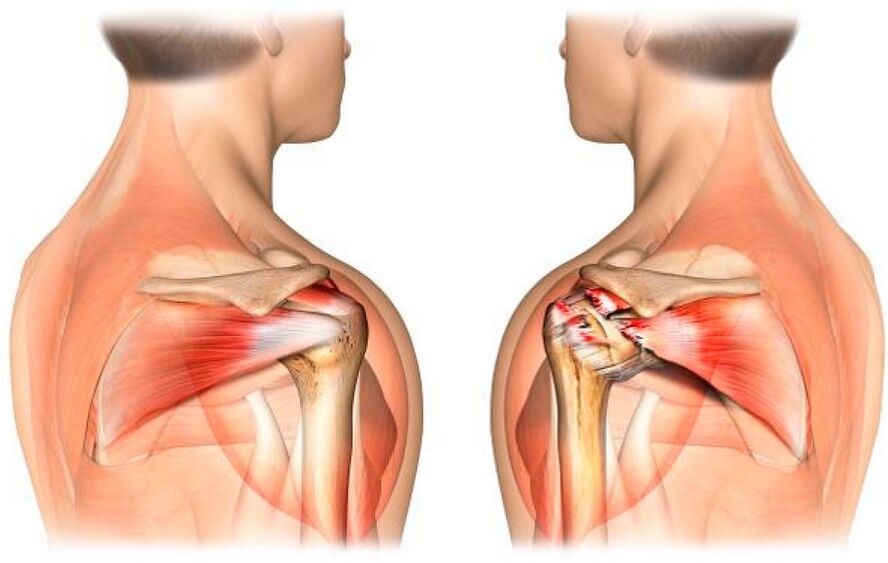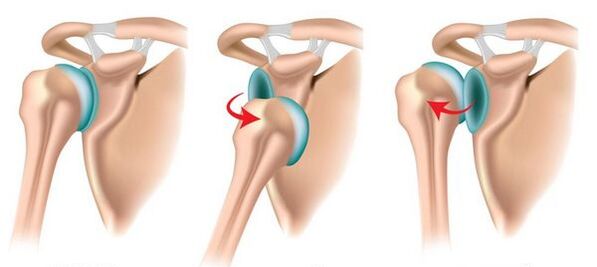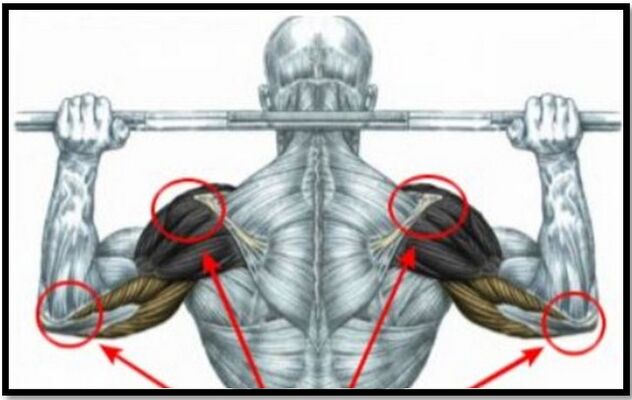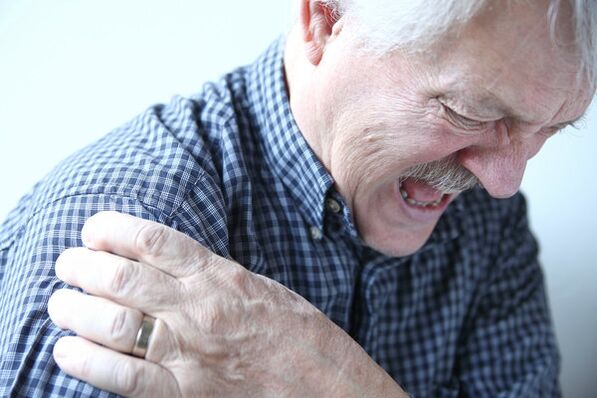
Deformation of shoulder joint arthrosis is a common pathology, especially in older patients. This disease is chronic and develops rapidly. It is equally often diagnosed in patients of both sexes. Due to degenerative disorders, damage is observed not only in joint cartilage tissue, but also in bone tissue. The cause of the problem is a microtraumatic injury to the shoulder joint and the inflammatory process that develops in it. Cartilage gradually becomes thinner, microcracks appear on it, where salt deposits accumulate. Then the destructive process gradually affects the bone, which becomes denser, grows, and finally changes its anatomical shape. The disease develops over a long period of time, without causing any discomfort to a person in the early stages of the disease. Actually, this is where the danger lies. Let us discuss in more detail the causes, symptoms, as well as how and with what to treat deforming arthrosis.
Why does pathology occur?
Among the causes of shoulder joint arthrosis, experts name the following conditions and factors.
Traumatic injury
Shoulder injuries include intra-articular fractures, dislocations, and contusions. Fractures are characterized by the fact that the fracture line is located in the articulation cavity. In addition to the bones, it also affects the cartilage, causing additional injuries: torn ligaments, damaged capsules.
Shoulder dislocation is one of the most common injuries, often leading to complications, joint deformation, and the development of arthrosis. As a result, the joint may lose its mobility completely.

Dislocation of the right shoulder is observed more often in the right hand, and the left in the left hand.
Bruises occur as a result of a strong impact, for example as a result of an accident, fall or sports. Because of the bruise, the bone does not shift, the cartilage tissue is not destroyed, but its normal nutrition is disturbed, which can also cause arthrosis after trauma.
Increased burden
Excessive load on the shoulder joint is observed in several groups of people:
- Professional athletes: volleyball players, tennis players, track and field athletes.
- Builder, patcher, loader.
- Dachnikov.

They all have to make the same type of movement with the raised hand for a long time. Therefore, they suffer from micro-cracks and injuries, sprained ligaments, over-stretched muscles, and impaired blood vessel function. Joints lack nutrients and become deformed.
If a person does not monitor the load and does not take preventive measures, then glenohumeral arthrosis may occur.
Joint pathology
Some articular pathologies can trigger the development of deforming arthrosis.
- Synovitis. The cause is an infection that causes the formation of intense intra-articular fluid. Due to the accumulation of fluid, the joint swells and begins to hurt. Often this problem is observed in connection with shoulder injuries. If synovitis is not treated, there is a high probability of complications. This disease is treated with therapeutic agents. Pain is relieved with NSAIDs. In addition, the patient will undergo a puncture to pump out the fluid that accumulates in the joint. The shoulder is then fixed in a stationary position. Infectious synovitis is treated with antibiotics. In the most difficult situations, surgical treatment is performed.
- Shoulder joint arthritis of various origins. The signs: shoulder swelling and significant pain in the joints.
- Bone necrosis also causes shoulder joint arthrosis. Triggered by injury or genetics, it is characterized by the fact that bone cells begin to die. Medicine offers therapeutic or surgical correction of the condition, depending on the stage of the disease and the individual characteristics of the body. Chondroprotectors restore bone tissue, and NSAIDs help cope with pain. The use of medications is supplemented with physiotherapy, massage, and exercise therapy.
Hereditary, congenital, acquired pathology
Various anomalies in the structure of the shoulder (congenital or acquired) almost always change its shape. The consequence of muscular dystrophy is insufficient nutrition of the joint tissue, and then shoulder arthrosis.
If a person has a lack of collagen, this will also trigger the development of pathology.
The possibility of getting shoulder arthrosis is higher in people whose relatives have similar problems, including coxarthrosis, gonarthrosis, because the lack of cartilage tissue development is inherited.
Blood vessel disease
Conditions in which the possibility of arthrosis of the shoulder joint increases are considered to be various disorders in the function of blood vessels.
- Physical inactivity also significantly increases the likelihood of developing pathology. It is caused by insufficient physical activity. The disease is characterized by apathy, drowsiness, decreased appetite, and insomnia. One of the most common complications of physical inactivity is cardiovascular disease, such as atherosclerosis. This disease is treated conservatively; it also needs to follow diet and exercise therapy.
- Eliminates endarteritis. Pathology occurs due to impaired blood circulation, which results in a lack of oxygen supply to the vessel tissue. Therefore, their performance is limited, and then they die.
- Poor nutrition and insufficient physical activity are the conditions for obesity and impaired metabolism, which leads to difficult blood circulation in the joint tissue. The result of that process is the development of arthrosis.
- Varicose veins, where the blood flow in the vessels slows down, is also one of the conditions that trigger degenerative changes in the joints.
Hormonal imbalance and weak immunity
Disrupted hormone levels and reduced immunity can be factors that cause destructive tendencies in joint tissue.
- The changes that occur in a woman's body due to menopause are characterized by metabolic disorders. The lack of calcium in the bones during this period is the result of a decrease in estrogen levels in the female body. The consequence of this process is the possibility of joint arthrosis.
- Psoriasis is a non-infectious chronic pathology caused by various reasons (stress, decreased immunity, impaired metabolism, etc. ). This disease is systemic, therefore, in certain conditions, not only the skin, but also internal organs, bones, and joints can be affected.
- Men often experience arthrosis due to gout. It occurs due to excessive accumulation of uric acid in the form of small crystals in the joints. Signs of pathology include joint swelling and pain. Externally, their manifestation can be observed at the time of exacerbation of paroxysmal gout. This usually happens at night. The shoulder feels hot and the skin becomes red. In an advanced state, gout can be a provoking factor for the development of pathology. To avoid complications, gout must be treated with medication, not forgetting diet and exercise therapy.
- Decreased immunity may be the cause of arthrosis due to the worsening of the inflammatory process in the joint cavity.
Metabolism is affected
The lack of intake of various vitamins and microelements into the body (especially calcium, phosphorus, vitamin D) often causes nutritional deficiency of intra-articular fluid, cartilage and joint bone tissue, which in turn causes degenerative-dystrophic changes in them.
Due to diabetes, blood vessels become thinner, blood flow through them decreases, and periarticular tissues do not receive enough nutrients. All this leads to arthrosis.
Age-related changes
With age, bones and cartilage become thinner and weaker. The likelihood of developing shoulder arthrosis after the age of 50 increases dramatically.

Most often, shoulder arthrosis is observed due to exposure to the complex of conditions listed.
symptoms
Deformed arthrosis of the shoulder joint is characterized as a disease that develops gradually over a long period of time. At first, it does not show anything, however, at a later stage of development, the following symptoms are observed.
- Shoulder pain. Its character, most often sick, attractive, disturbs a person in the morning, after a night's rest. May occur before the weather changes. If physical activity is required on the affected shoulder, the pain becomes intense and noticeable. When the condition worsens, the pain syndrome manifests itself even at rest. Wearing an orthosis helps solve the problem.
- Impaired motor activity in the affected arm occurs as a result of severe pain. Exacerbations often occur due to hypothermia or sprained ligaments. The patient cannot lift his arm or perform normal movements. He experiences excruciating pain when making circular movements in the shoulder or trying to move his arm back. If therapy is not started in time, complete immobilization of the upper limb may occur.
- The crunch and creasing of the joint is not very noticeable at first and may be barely noticeable. Then they become intense and can be heard not only by the patient, but also by the people around him.
- Inflammation of the joints is manifested by edema, swelling, a local increase in skin temperature and redness.
- The feeling of joint stiffness is caused by the growth of bone tissue - osteophytes, which manifests itself if the disease progresses.
Disease development
This disease goes through three stages in its development. The symptoms at each stage are similar to each other, however, they differ significantly in intensity.
Arthrosis degree 1
Arthrosis of the shoulder joint of the 1st degree is characterized by a slight pain in the morning and evening. The patient "builds" the joint with effort before performing the movement. Slight irritation on the shoulder is possible if someone jerks his hand sharply. During rest, no pain is felt.
second degree
Arthrosis of the shoulder joint of the 2nd degree is indicated by more severe pain, a rattling sound in the shoulder is clearly audible. Hand mobility is still preserved, but is significantly reduced. The destruction process is already there, the joint tissue gradually becomes thinner, and dystrophy is observed. Ligaments, cartilage, and bone are affected. Wearing a special orthopedic device - orthosis or bandage - helps reduce the intensity of pain.
Arthrosis 3 degrees
The third stage of the disease is the worst. Symptoms of arthrosis significantly change a person's quality of life. The patient could only turn his arm slightly, he constantly had acute pain in the shoulder, and joint deformation was observed. Muscles are partially atrophied. The problem was solved by surgery. In its absence, complete disability and disability are possible.
Treatment
It is impossible to cure arthrosis deformans. You can only slow down its development and affect the symptoms. Doctors offer two types of treatment for arthrosis deformation of the shoulder joint: therapeutic and surgical.
Therapeutic treatment
As a therapeutic correction of the patient's condition, the doctor suggests using the following group of drugs.
- Nonsteroidal anti-inflammatory drugs. The main goal at this stage of treatment is to relieve inflammation and pain. Medicines suppress the inflammatory process and relieve pain. It is important to remember that NSAIDs are used for a limited time. They are prescribed in the form of tablets and injections.
- Treatment of shoulder joint arthrosis involves the use of corticosteroids. They help relieve inflammation, thereby stopping the development of pathology.
- Chondroprotectors for arthrosis are prescribed at the non-acute stage to restore damaged cartilage and bone tissue. These drugs are based on various active ingredients: glucosamine, chondroitin sulfate, hyaluronic acid. They help stop the destruction of cartilage tissue and restore it. But the effectiveness of the use of chondroprotectors can be expected only in the early stages of the disease, because for their action, the main condition is necessary - cartilage tissue must remain in the affected joint. Otherwise, these drugs will not help. All these drugs are prescribed by a doctor. You can expect positive results from its use no earlier than after six months of use.
- External agents (ointments, gels, creams) are also widely used in the treatment of arthrosis.
- Analgesics also relieve pain and are used inconsistently.
Surgery
The operation is performed at the third stage of pathological development. It consists of prosthetic replacement of the shoulder and scapula. Surgical treatment has contraindications, usually the advanced age of the patient.
The decision on how to treat arthrosis of the shoulder joint will be made by an orthopedic specialist or traumatologist.
Additional methods of conservative treatment of shoulder arthrosis include exercise therapy, massage, and traditional medicine. A prerequisite for this method is that it cannot be used during the aggravation period.
With shoulder arthrosis, physical therapy can significantly reduce the patient's condition. In the exercise set, you need to choose simple movements (circular movements, lifting, flexion-extension of the arm). Gymnastics is carried out at a calm pace, without loads.
Self treatment
For home treatment, you can use folk recipes. But its use must be agreed with the attending physician.
- Rubbing sore joints helps a lot with arthrosis. A rub is prepared from 50 g of elecampane root and 125 ml of vodka. Colored left for two weeks in a dark place, then used to rub shoulders before going to bed.
- Compressed oats are easy to make yourself. Take 30 g of flakes per half liter of water and boil for 8-10 minutes. The decoction is moistened with gauze folded several times, then applied to the affected joint for half an hour.
- You can use cabbage leaves as a compress (at night). They cope well with pain.
- Herbal baths are recommended for the treatment of arthrosis deformans. Mustard, mint, and burdock are used to prepare it.

Shoulder joint arthrosis, like any other joint disease, should not be ignored. The treatment must be approached comprehensively, follow the doctor's instructions: take the medicine in a disciplined way, do a complex of exercise therapy. To avoid arthrosis, you should not overload your joints, avoid being too cold, and watch your diet.

















































